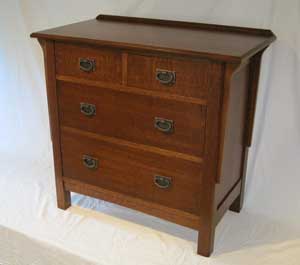
Drawers for a Dresser
Some of our readers responded to the questions appearing in the Q&A section of last issue’s eZine. For instance, we heard from one reader who had also built a Craftsman dresser. – Editor
“I just read the replies to the question about fitting drawers for a Craftsman dresser. As an intermediate hobby woodworker who just finished a Craftsman dresser, I found the answers not very helpful. For those of us who are mostly self-taught, saying, ‘Do it just like the old masters did’ doesn’t help much since you don’t know what/how they did it. I found an article on NK drawers — a method that greatly simplifies the process of drawer fitting. And, yes, my drawers pass the ‘finger on four corners’ test.” – Leslie Melim
Defining Double-Profile Doors
And others who discussed double-profile doors. – Editor
“I would guess that double-profile doors would be a door that has a profile on both sides like in a raised panel cabinet door or on a front door that has a raised panel on both sides. That’s just my guess.” – Karl Riley
“I am probably wrong, but it has been my understanding that ‘double-profile doors’ are exactly what Tim Inman stated, profiled on both ends. I say this because, when offered in most of the catalogues, that is how they are described. The same applies to raised panel doors. If it’s raised on both sides it’s doubled. Most raised panel doors today are only raised on ‘one’ side.” – Ed Miller
Ways to Make Wheels
… or wheels. – Editor
“This is for the gentleman who is making wooden toys for his grandchildren, but is having problems making the wheels. Depending on how fancy he wants to get, all he needs to do is get himself some hole saws in different sizes (the kind you use for installing doorknobs). Just put one (hole saw) in your drill press (or drill), and out comes a wheel with the axle hole perfectly centered. He should probably use one that’s non-adjustable, as I’ve found they make cleaner cuts.” – Aaron Worden
“Wow – I can’t believe you missed the opportunity here to expound on the use of the router for making wheels! First, since all wheels have a center, that is the logical place to put a center about which to rotate the router.
“For large wheels, you can use the axle hole to place the center of the router’s base plate for making large circles. For small wheels [under three inches] you could use a hole saw, or turn them on the lathe. If you like the router approach, use a trim router and make a circle-cutting base plate, just like for larger routers. I think the choices are many and varied as are the minds of woodworkers who can solve most problems like this given a little time and thinking outside the box, as they say!” – Gordon Patnude
“My standard go-to for toy wheels? A simple hole saw (you know, one of those things with a cylindrical blade and a center guide bit). You get a consistent disk with a centered hole for the axle. If you want to dress it up afterwards on a lathe (to shape the face, for example), that’s no problem.” – Herb Hedstrom
“I read in some of your articles and Q&A sections about cutting circles for assorted projects, and the answer is always a jig and the band saw. Has no one there ever used a table saw to cut circles? Much easier, and they all come out perfect! Surely you guys know how it is done?” – Terry Homer
It is safer to do circle cutting on a band saw. – Editor
Talking of Tapers
And another reader was still speaking of tapered legs. – Editor
“When cutting tapered legs, after I get the correct angle, I will put a piece of Masonite [hardboard] over my saw. The fence and a couple of squeeze clamps will hold it in place. The jig and led slide smoothly across. You can even cut Masonite much wider than the saw and notch it out for the fence to give you a nice expensive table saw extension with a zero clearance table insert.” – Ted Hyde





